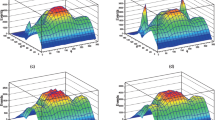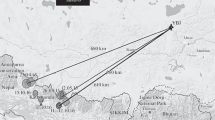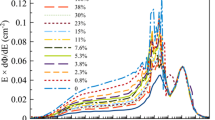Abstract
The new type of EAS array consisting of EN-detectors possesses the ability to discriminate the composition of cosmic rays. At the Yangbajing Cosmic Ray Observatory, the PRISMA-16-YBJ array has been running for three years. We installed 16 so-called “sand cubes” with one cubic meter size, and compared the data obtained by placing PRISMA-16-YBJ on and away from the sand cubes to study the influence of target material, which is a major environmental factor, on the performance of the array.







Similar content being viewed by others
Data Availability
Data will be made available on reasonable request.
References
Amenomori, M., Ayabe, S., Chen, D., et al.: Are protons still dominant at the knee of the cosmic-ray energy spectrum? Phys. Lett. B 632(1), 58–64 (2006)
Antoni, T., Apel, W.D., Badea, A.F., et al.: KASCADE measurements of energy spectra for elemental groups of cosmic rays: results and open problems. Astropart. Phys. 24(1–2), 1–25 (2005)
Bartoli, B., Bernardini, P., Bi, X.J., et al.: Knee of the cosmic hydrogen and helium spectrum below 1 PeV measured by ARGO-YBJ and a Cherenkov telescope of LHAASO. Phys. Rev. D 92, 092005 (2015)
Bartoli, B., Bernardini, P., Bi, X.J., et al.: Detection of thermal neutrons with the PRISMA-YBJ array in extensive air showers selected by the ARGO-YBJ experiment. Astropart. Phys. 81, 49–60 (2016)
Kulikov, G.V., Khristiansen, G.B.: On the size spectrum of extensive air showers. Sov. Phys. JETP 35(8), 441–444 (1959)
Li, B.B., Alekseenko, V.V., Chen, T.L., et al.: EAS thermal neutron detection with the PRISMA-LHAASO-16 experiment. J. Instrum. 12(12), P12028 (2017)
Li, B.B., Cui, S.W., Shi, C., et al.: Electron–Neutron Detector Array (ENDA). Phys. At. Nucl. 84(6), 181–186 (2021)
Liu, M.Y., Alekseenko, V., Cui, S.W., et al.: Performance of the thermal neutron detector array in Yangbajing, Tibet for cosmic ray EAS detection. Astrophys. Space Sci. 365(7), 1–6 (2020)
Ma, X.H., Bi, Y.J., Cao, Z., et al.: Chapter 1 LHAASO instruments and detector technology. Chin. Phys. C 46(3), 030001 (2022)
Stenkin, Y.V.: On the PRISMA project. Nucl. Phys. B, Proc. Suppl. 196, 293–296 (2009)
Stenkin, Y.V., Valdes-Galicia, J.F.: On the neutron bursts origin. Mod. Phys. Lett. A 17(26), 1745–1751 (2002)
Stenkin, Y.V., Alekseenko, V.V., Gromushkin, D.M., et al.: Thermal neutron flux produced by EAS at various altitudes. Chin. Phys. C 37(1), 015001 (2013)
Acknowledgements
We acknowledge the essential support of Yong Liu in installation of the array and the sand cubes and Ji-Biao Li working on SEM and EDS at HNU.
Funding
This work was supported in China by the National Natural Science Foundation of China (NSFC) (grant number 11963004, U2031103, U1831208, 11905043, 12105293, U1831129, and 12147218), the Everest Discipline Construction Plan of Tibet University, and the Science and Technology Department of Sichuan Province (grant number 2021YFSY0031).
Author information
Authors and Affiliations
Contributions
Denis Kuleshov, Kirill Kurinov, Alexandra Lagutkina, Kirill Levochkin, Oleg Shchegolev and Yuri Stenkin contributed to detectors design. Di-Xuan Xiao, Tian-Lu Chen, Danzengluobu and Mao-Yuan Liu contributed to data analysis and detector installation. Wei Gao, Xin-Hua Ma and Li-Qiao Yin contributed to data analysis. Shu-Wang Cui, Bing-Bing Li, Ye Liu, Fan Yang and Liang-Wei Zhang contributed to array testing and simulation.
Ethics declarations
Conflict of Interest
The authors declare that they have no conflicts of interest.
Additional information
Publisher’s Note
Springer Nature remains neutral with regard to jurisdictional claims in published maps and institutional affiliations.
Rights and permissions
Springer Nature or its licensor holds exclusive rights to this article under a publishing agreement with the author(s) or other rightsholder(s); author self-archiving of the accepted manuscript version of this article is solely governed by the terms of such publishing agreement and applicable law.
About this article
Cite this article
Xiao, DX., Chen, TL., Cui, SW. et al. Influence of soil environment on performance of EAS electron–neutron detector array. Astrophys Space Sci 367, 75 (2022). https://doi.org/10.1007/s10509-022-04103-z
Received:
Accepted:
Published:
DOI: https://doi.org/10.1007/s10509-022-04103-z




